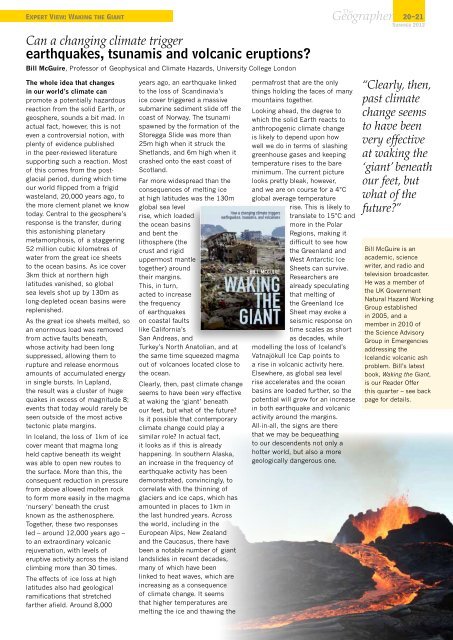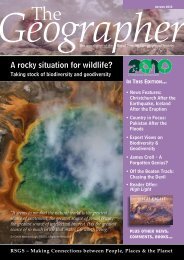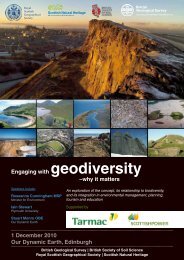Summer - Royal Scottish Geographical Society
Summer - Royal Scottish Geographical Society
Summer - Royal Scottish Geographical Society
Create successful ePaper yourself
Turn your PDF publications into a flip-book with our unique Google optimized e-Paper software.
The<br />
Expert View: Waking the Giant Geographer 20-21<br />
<strong>Summer</strong> 2012<br />
Can a changing climate trigger<br />
earthquakes, tsunamis and volcanic eruptions?<br />
Bill McGuire, Professor of Geophysical and Climate Hazards, University College London<br />
The whole idea that changes<br />
in our world’s climate can<br />
promote a potentially hazardous<br />
reaction from the solid Earth, or<br />
geosphere, sounds a bit mad. In<br />
actual fact, however, this is not<br />
even a controversial notion, with<br />
plenty of evidence published<br />
in the peer-reviewed literature<br />
supporting such a reaction. Most<br />
of this comes from the postglacial<br />
period, during which time<br />
our world flipped from a frigid<br />
wasteland, 20,000 years ago, to<br />
the more clement planet we know<br />
today. Central to the geosphere’s<br />
response is the transfer, during<br />
this astonishing planetary<br />
metamorphosis, of a staggering<br />
52 million cubic kilometres of<br />
water from the great ice sheets<br />
to the ocean basins. As ice cover<br />
3km thick at northern high<br />
latitudes vanished, so global<br />
sea levels shot up by 130m as<br />
long-depleted ocean basins were<br />
replenished.<br />
As the great ice sheets melted, so<br />
an enormous load was removed<br />
from active faults beneath,<br />
whose activity had been long<br />
suppressed, allowing them to<br />
rupture and release enormous<br />
amounts of accumulated energy<br />
in single bursts. In Lapland,<br />
the result was a cluster of huge<br />
quakes in excess of magnitude 8;<br />
events that today would rarely be<br />
seen outside of the most active<br />
tectonic plate margins.<br />
In Iceland, the loss of 1km of ice<br />
cover meant that magma long<br />
held captive beneath its weight<br />
was able to open new routes to<br />
the surface. More than this, the<br />
consequent reduction in pressure<br />
from above allowed molten rock<br />
to form more easily in the magma<br />
‘nursery’ beneath the crust<br />
known as the asthenosphere.<br />
Together, these two responses<br />
led – around 12,000 years ago –<br />
to an extraordinary volcanic<br />
rejuvenation, with levels of<br />
eruptive activity across the island<br />
climbing more than 30 times.<br />
The effects of ice loss at high<br />
latitudes also had geological<br />
ramifications that stretched<br />
farther afield. Around 8,000<br />
years ago, an earthquake linked<br />
to the loss of Scandinavia’s<br />
ice cover triggered a massive<br />
submarine sediment slide off the<br />
coast of Norway. The tsunami<br />
spawned by the formation of the<br />
Storegga Slide was more than<br />
25m high when it struck the<br />
Shetlands, and 6m high when it<br />
crashed onto the east coast of<br />
Scotland.<br />
Far more widespread than the<br />
consequences of melting ice<br />
at high latitudes was the 130m<br />
global sea level<br />
rise, which loaded<br />
the ocean basins<br />
and bent the<br />
lithosphere (the<br />
crust and rigid<br />
uppermost mantle<br />
together) around<br />
their margins.<br />
This, in turn,<br />
acted to increase<br />
the frequency<br />
of earthquakes<br />
on coastal faults<br />
like California’s<br />
San Andreas, and<br />
Turkey’s North Anatolian, and at<br />
the same time squeezed magma<br />
out of volcanoes located close to<br />
the ocean.<br />
Clearly, then, past climate change<br />
seems to have been very effective<br />
at waking the ‘giant’ beneath<br />
our feet, but what of the future?<br />
Is it possible that contemporary<br />
climate change could play a<br />
similar role? In actual fact,<br />
it looks as if this is already<br />
happening. In southern Alaska,<br />
an increase in the frequency of<br />
earthquake activity has been<br />
demonstrated, convincingly, to<br />
correlate with the thinning of<br />
glaciers and ice caps, which has<br />
amounted in places to 1km in<br />
the last hundred years. Across<br />
the world, including in the<br />
European Alps, New Zealand<br />
and the Caucasus, there have<br />
been a notable number of giant<br />
landslides in recent decades,<br />
many of which have been<br />
linked to heat waves, which are<br />
increasing as a consequence<br />
of climate change. It seems<br />
that higher temperatures are<br />
melting the ice and thawing the<br />
permafrost that are the only<br />
things holding the faces of many<br />
mountains together.<br />
Looking ahead, the degree to<br />
which the solid Earth reacts to<br />
anthropogenic climate change<br />
is likely to depend upon how<br />
well we do in terms of slashing<br />
greenhouse gases and keeping<br />
temperature rises to the bare<br />
minimum. The current picture<br />
looks pretty bleak, however,<br />
and we are on course for a 4°C<br />
global average temperature<br />
rise. This is likely to<br />
translate to 15°C and<br />
more in the Polar<br />
Regions, making it<br />
difficult to see how<br />
the Greenland and<br />
West Antarctic Ice<br />
Sheets can survive.<br />
Researchers are<br />
already speculating<br />
that melting of<br />
the Greenland Ice<br />
Sheet may evoke a<br />
seismic response on<br />
time scales as short<br />
as decades, while<br />
modelling the loss of Iceland’s<br />
Vatnajökull Ice Cap points to<br />
a rise in volcanic activity here.<br />
Elsewhere, as global sea level<br />
rise accelerates and the ocean<br />
basins are loaded further, so the<br />
potential will grow for an increase<br />
in both earthquake and volcanic<br />
activity around the margins.<br />
All-in-all, the signs are there<br />
that we may be bequeathing<br />
to our descendents not only a<br />
hotter world, but also a more<br />
geologically dangerous one.<br />
“Clearly, then,<br />
past climate<br />
change seems<br />
to have been<br />
very effective<br />
at waking the<br />
‘giant’ beneath<br />
our feet, but<br />
what of the<br />
future?”<br />
Bill McGuire is an<br />
academic, science<br />
writer, and radio and<br />
television broadcaster.<br />
He was a member of<br />
the UK Government<br />
Natural Hazard Working<br />
Group established<br />
in 2005, and a<br />
member in 2010 of<br />
the Science Advisory<br />
Group in Emergencies<br />
addressing the<br />
Icelandic volcanic ash<br />
problem. Bill’s latest<br />
book, Waking the Giant,<br />
is our Reader Offer<br />
this quarter – see back<br />
page for details.








